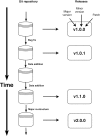Datastorr: a workflow and package for delivering successive versions of 'evolving data' directly into R
- PMID: 31042286
- PMCID: PMC6506717
- DOI: 10.1093/gigascience/giz035
Datastorr: a workflow and package for delivering successive versions of 'evolving data' directly into R
Abstract
The sharing and re-use of data has become a cornerstone of modern science. Multiple platforms now allow easy publication of datasets. So far, however, platforms for data sharing offer limited functions for distributing and interacting with evolving datasets- those that continue to grow with time as more records are added, errors fixed, and new data structures are created. In this article, we describe a workflow for maintaining and distributing successive versions of an evolving dataset, allowing users to retrieve and load different versions directly into the R platform. Our workflow utilizes tools and platforms used for development and distribution of successive versions of an open source software program, including version control, GitHub, and semantic versioning, and applies these to the analogous process of developing successive versions of an open source dataset. Moreover, we argue that this model allows for individual research groups to achieve a dynamic and versioned model of data delivery at no cost.
Keywords: data sharing; semantic versioning; version control.
© The Author(s) 2019. Published by Oxford University Press.
Figures


References
-
- Whitlock MC. Data archiving in ecology and evolution: best practices. Trends Ecol Evol. 2011;26:61–5. - PubMed
-
- Fairbairn DJ. The advent of mandatory data archiving. Evolution. 2011; 65:1–2. - PubMed
-
- Piwowar HA, Vision TJ, Whitlock MC. Data archiving is a good investment. Nature. 2011;473(7347):285. - PubMed
-
- Van Noorden R. Data-sharing: everything on display. Nature. 2013;500(7641):243–5. - PubMed
-
- Gibney E, Van Noorden R. Scientists losing data at a rapid rate. Nat News. 2013,doi:10.1038/nature.2013.14416. - DOI
Publication types
MeSH terms
LinkOut - more resources
Full Text Sources
Molecular Biology Databases

